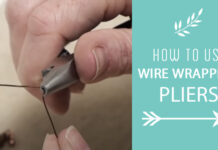Jump rings are an integral part of jewelry making. Used to secure findings and clasps together or just as a jewelry connector between beads and chain, jump rings have a variety of jewelry making applications. Split rings are not created equal to jump rings in the jewelry making world. Here are some of the key differences between a jump ring and split ring.
Jump Rings vs. Split Rings
Jump rings are most commonly defined as a circle of wire that meets at the end and is not welded together. A split ring consists of two complete turns of a helix and pressed flat together where objects can be strung on them. This makes each ring be associated with a different type of security level.
A jump ring has the potential of becoming opened while a split ring is secured by more than a complete rotation of the wire. While at first glance it may seem like a split ring is a better option for keeping your piece together, here is a listing of cons to using jump rings.

4 Cons to Using Split Rings
Split rings have a place in the connector world for use as key chains and zipper pulls. However, they are not the most desirable for use on jewelry for a number of key reasons.
1. Exposed Ends
Since the end of split rings do not meet in the middle, this leaves two exposed ends at the end. Split rings do not meet flush in the middle like a traditional round jump ring allowing your skin to be rubbed against harshly.
2. Snagging
The exposed ends of split rings can cause your clothing to snag or hair to become caught up in it. If a jump ring was properly secured, you would never find it snagging or scratching you.
3. Spreading
A split ring can eventually spread open over time when under heavy use or while putting a piece together. This can create the same risk of losing a charm or connection as a jump ring.
4. False Sense of Security
The shape of the split ring can lead you to a false sense of security. It depends on the gauge and size of the ring as to is ability to become the safest connection choice for your piece.
Selecting the Right Size of Jump Rings and Split Rings
Making the right connection choice for your piece all depends on one major factor: the size. The split ring size commonly used for jewelry is too weak or usually too thin. You usually see 20 gauge (0.81mm thick) or 22 gauge (0.64mm thick) as options. Split rings are great for making key chains, zipper pulls, tag connectors and more. These are usually created with at least a 16 gauge (1.2mm thick) or thicker. In order to be successful, you would want to use a thicker gauge ring for your jewelry piece.
The same thing goes for jump rings that are commonly manufactured with 20 gauge (0.81mm thick). A 18 gauge (1.02mm thick) wire is still small but considered to be stronger when used as an attachment on necklaces and bracelets. Use 20 gauge rings for earrings and more lightweight uses.
Selecting the Best Shape Jump Ring
Unlike split rings, jump rings come in a variety of shapes and sizes. Just check out this post on 10 Perfect Types of Jump Rings for Jewelry Making for a list. One of the most popular differences exist between the round and oval jump rings. Oval jump rings are a great option to use with clasps or ending connectors. Because their gap is not in the middle, your cord may be less likely to slip through. You can also choose from a variety of snap closed and locked jump rings to ensure you have extra added security for round shaped rings.
Proper Technique for Opening and Closing Jump Rings
One of the most important things to consider when using jump rings is if you are properly opening and closing them. This can make a big difference in how their future integrity remains in securing the component in the long term.
Make Your Own Jump Rings
Once you are confident in using jump rings and split rings, consider making your own components and findings. Simply grab a few pairs of pliers, thick gauge wire, and follow the directions below.






